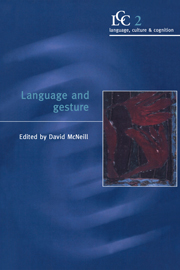Part 4 - From gesture to sign
Published online by Cambridge University Press: 07 January 2010
Summary
The topic of gesture gains added importance because of its connections to the topic of sign linguistics. These connections are of interest in part because they are, in fact, problematic. A major question is, Do the deaf make gestures? And beyond this puzzle, what in general is the relationship of sign language to natural gesture? These questions and others are the themes of part 4.
The gesticulations at one end of Kendon's continuum (see the introduction) can be related to sign languages at the other end on three timescales – real time (the possibility of a gesture occurring during signed utterances and what constrains it), historical time (the emergence of a sign language), and evolutionary time (the possible place of signs in the origin of human language abilities). The chapters in this part conveniently focus on these timescales.
Liddell presents an analysis of the ‘gestural' in realtime American Sign Language usage. He argues that gesture is incorporated in the form of deixis (thus Liddell makes contact with Haviland's discussion of deixis), a use for which the structure of ASL itself makes provisions.
Morford & Kegl in their chapter take up the historical dimension by describing the remarkable situation that has arisen in Nicaragua since the Sandinista Revolution. Deaf people who previously had been isolated were brought together for the first time, and out of this natural contact a new language has emerged, nearly all of it recorded on video.
- Type
- Chapter
- Information
- Language and Gesture , pp. 329 - 330Publisher: Cambridge University PressPrint publication year: 2000

